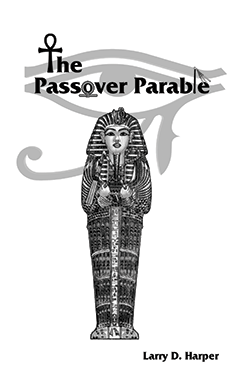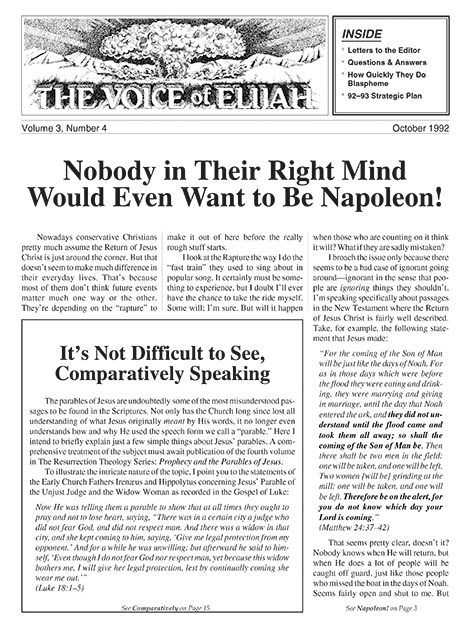A Parabolic Image Is a Mental Image the Prophets Used
A parabolic image is the first of the two constituent parts of a parable, with the second constituent part being a Hebrew idiom. A parabolic image is a mental image that Moses and the Prophets of Israel used in their prophecies to speak concerning God’s purpose in the birth, life, death, and Resurrection of Jesus Christ. For example, the Prophets of Israel state many things parabolically concerning Jesus Christ in terms of “The House” of Israel and “The House” of David.
This particular parabolic image—the parabolic image of “The House”—is used extensively in both the Hebrew and Greek Scriptures. For instance, Jesus alludes to the parabolic image of “The House” in His parable about the wise man who “built his house” on the rock and the fool who “built his house” on the sand:
“Therefore everyone who hears these words of Mine, and acts upon them, may be compared to a wise man, who built his house upon the rock. And the rain descended, and the floods came, and the winds blew, and burst against that house; and {yet} it did not fall, for it had been founded upon the rock. And everyone who hears these words of Mine, and does not act upon them, will be like a foolish man, who built his house upon the sand. And the rain descended, and the floods came, and the winds blew, and burst against that house; and it fell, and great was its fall.”
(Matthew 7:24–27) —NASB
(Note: “The rock,” “the rain,” “the floods,” “the winds,” and “the sand” in this parable are also parabolic images whose meaning and significance are explained in the prophecies of Moses and the other Prophets of Israel.)
The Apostle Peter also uses the parabolic image of “The House” to parabolically depict True Believers as “living stones” who are being “built” into a spiritual “house”:
And coming to Him as to a living stone, rejected by men, but choice and precious in the sight of God, you also, as living stones, are being built up as a spiritual house for a holy priesthood, to offer up spiritual sacrifices acceptable to God through Jesus Christ.
(1 Peter 2:4–5) —NASB
The Apostle Paul refers to the same parabolic image when he says this in his first epistle to the Corinthians:
According to the grace of God which was given to me, as a wise master builder I laid a foundation, and another is building upon it. But let each man be careful how he builds upon it. For no man can lay a foundation other than the one which is laid, which is Jesus Christ. Now if any man builds upon the foundation with gold, silver, precious stones, wood, hay, straw, each man’s work will become evident; for the day will show it, because it is {to be} revealed with fire; and the fire itself will test the quality of each man’s work. If any man’s work which he has built upon it remains, he shall receive a reward. If any man’s work is burned up, he shall suffer loss; but he himself shall be saved, yet so as through fire.
(1 Corinthians 3:10–15) —NASB
The meaning and significance of the parabolic image of “The House” in the writings of Moses and the Prophets of Israel, as well as in the parabolic statements of Jesus and the Apostles, derive from the meaning and significance of the Hebrew idiom “build a house.” That’s because every parabolic image used by Moses and the other Prophets of Israel has at least one corresponding Hebrew idiom that both reveals and conceals the meaning and significance of that particular parabolic image.
Related Information

The Passover Parable
Jesus said the writings of Moses, the Prophets, and the Psalms—that is, the entirety of the Hebrew Scriptures—are all about Him (Luke 24:27, 44; John 5:46). Yet few today can find any reference to Jesus Christ in the Hebrew Scriptures because they don’t understand that God has used parables since the time of Moses to speak concerning His Son. The Passover Parable is at the heart of God’s message concerning His Firstborn Son, Jesus Christ. That message can be seen in the carefully orchestrated parabolic pantomime that God directed Corporate Israel, His Firstborn Son (Ex. 4:22), to enact during the Exodus of the sons of Israel from Egypt.

Nobody in Their Right Mind Would Even Want to Be Napoleon!
It is generally accepted that a perfectly rational person is one whose state of mind accurately reflects his state of being. The deluded fellow who believes he is Jesus Christ is generally accepted as being insane. Where does that leave all those people today who believe Satan’s lies? They insist everyone—themselves above all—is special to God (their deluded state of mind). Like a totally paranoid individual, they reject the Truth about their wretched spiritual condition (their actual state of being). This article makes the point that sanity, above all else, requires a knowledge of and belief in the Truth rather than a fantasy.

So Why Would a Nomad “Build a House” and Settle Down?
This is the second in a series of articles that, when complete, will explain how the Prophets concealed the first of seven messages hidden in the Hebrew Scriptures by their use of the ancient Hebrew idioms “build a house,” “raise up a seed,” and “make a name.” The first article in the series appeared in the July 1996 issue. This article explains the meaning and significance of some of the things Moses relates in his historical account of the Flood and the Tower of Babel. The point is, the message concerning “The House” explains the basis on which God expects the Blessed to make a distinction between themselves and the Cursed.

The Righteous and the Wicked: One Distinction Lies Between Them
This article explains the meaning and significance of the Greek and Hebrew terms translated “righteous” and “wicked” in the Scriptures. It discloses that although these two English terms accurately represented the meaning of the original text in 1611, when the King James version was translated, they now have no essential meaning at all. The article also explains the criterion God uses to determine who is “righteous” and who is “wicked.”
The Truth is Available
Check Out the Online Library
Browse through our library of eBooks and newsletters—absolutely free!
Start Reading Now